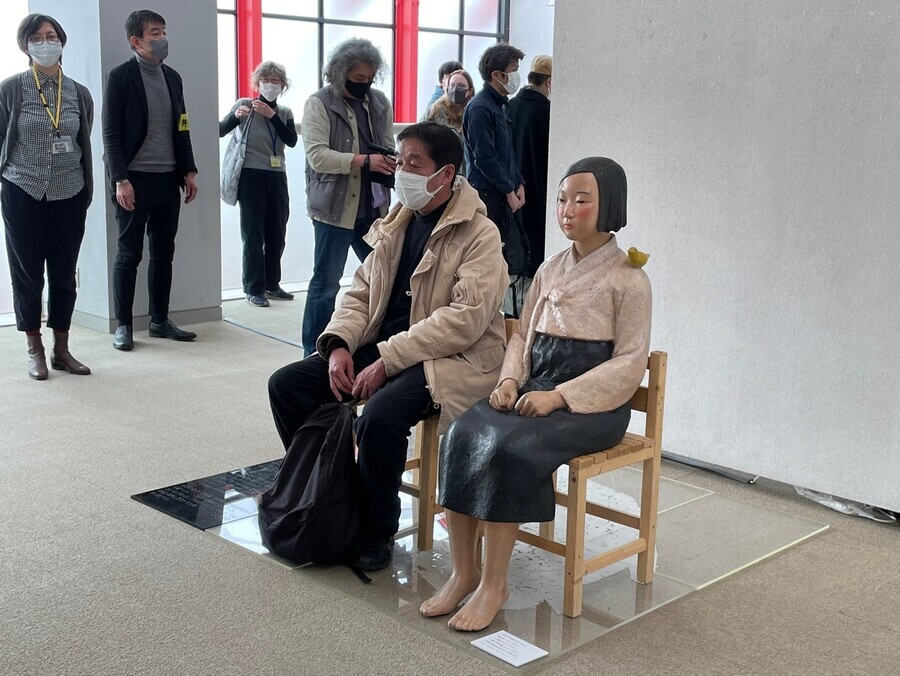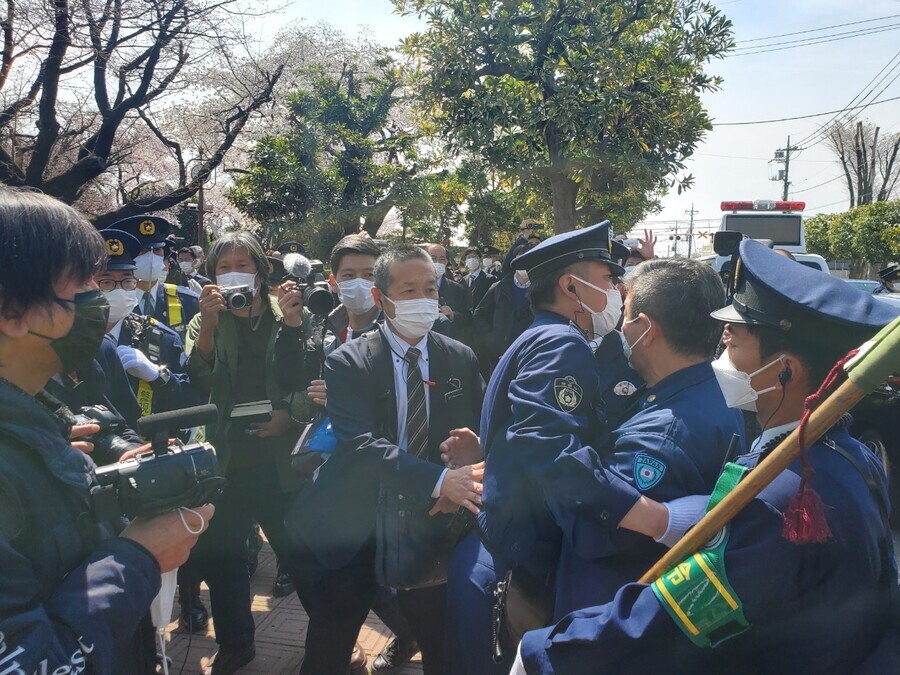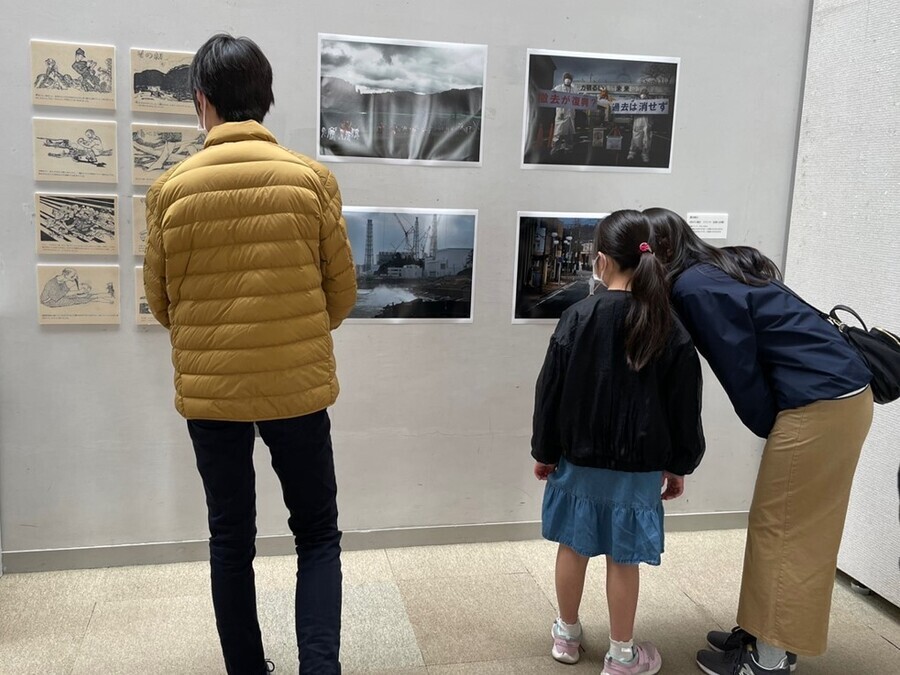hankyoreh
Links to other country sites 다른 나라 사이트 링크
“Comfort women” statue goes on display in Tokyo for first time in 7 years

The place was a gallery at the Kunitachi Community Arts Center, a public art institution in the city of Kunitachi in Japan’s Tokyo Prefecture. At 11 am Saturday, viewers stood in line as they began entering the “Non-Freedom of Expression Exhibition 2022,” which includes a statue of a young girl symbolizing victims of wartime sexual slavery by the Japanese military.
The exhibition was appearing before the public 10 months after it was originally scheduled to open in June 2021, only to be canceled due to sabotage tactics by right-wingers. It was the first such exhibition in Tokyo in the seven years and three months since January 2015, when another event was held at a private gallery in Nerima, a ward in the city.
Tension had been running high in the vicinity of the gallery since that morning.
Before the exhibition opened, right-wing groups began descending in force at around 10 am, using loudspeakers to shout phrases such as “Stop the exhibition” and “You’re a disgrace to Japan. Leave the country.” Some protesters even attempted to enter the gallery and ended up scuffling with the police who stopped them.

Across from them were citizens supporting the exhibition and holding up signs with messages such as “Hate speech is unforgivable.”
Admission to the exhibition took place on a reservation basis, with 40 visitors admitted per hour between 11 am and 8 pm. While the right-wing demonstrations continued, the viewers focused on the artwork.
The gallery visitors represented a broad range of the public, from senior citizens to mothers with children in tow. The Statue of Peace — an image of a young girl symbolizing the so-called comfort women — was located at the center of the gallery, where it attracted much attention.
One Japanese resident of Tokyo in his 50s sat for a while in the chair beside the statue before finally standing up.
“It’s been so difficult exhibiting the Statue of Peace in Japan, and I really wanted to see it for myself,” he explained. “I made a reservation last year, but unfortunately the exhibition was canceled.”
“Now that I’ve seen it, it makes me feel sad,” he added.
Another visitor, a Japanese woman in her 50s, also spent some time looking at the statue.
“I knew all about the Statue of Peace, but this is my first time seeing it in person,” she said.
“Seeing it like this, I found myself thinking about the ‘comfort women’ victims, which left me with a heavy heart,” she continued.
“It’s disappointing that this issue has yet to be resolved between Japan and Korea,” she added.
Commenting on the attempts by right-wingers to disrupt the exhibition, she said, “It’s unfortunate. Freedom of expression must be upheld.”

The exhibition, which features the work of 16 artists and artist teams, will run until Tuesday. In addition to the Statue of Peace, it also includes photographs of “comfort women” and artwork related to the Fukushima nuclear disaster, forced mobilization of Korean labor, and the emperor, who is considered a taboo topic to address in art in Japan.
Sadaaki Iwasaki is the co-representative for the Tokyo organizing committee for “Non-Freedom of Expression,” which includes representatives of Japanese civic groups.
“We don’t want to create the kind of society where it’s a common practice to forcibly take away opportunities to see artwork,” he said in a press conference that day.
“I’d really like to thank all the people whose help made this exhibition possible,” he added.
The organizing committee hoped the exhibition would draw around 1,600 visitors over its four-day run. For safety reasons, a total of 240 volunteers are working at the venue, while around 60 attorneys are providing support.
The Tokyo run appears likely to be followed by exhibitions in other regions of Japan this year. Organizing committee co-representative Yuka Okamoto explained that they’ve begun preparations for the exhibition in Nagoya that was called off last year.
“Organizing committees have also been formed to hold the exhibition in two other regions,” she added.
By Kim So-youn, Tokyo correspondent
Please direct questions or comments to [english@hani.co.kr]

Editorial・opinion
![[Column] Park Geun-hye déjà vu in Yoon Suk-yeol [Column] Park Geun-hye déjà vu in Yoon Suk-yeol](https://flexible.img.hani.co.kr/flexible/normal/500/300/imgdb/original/2024/0424/651713945113788.jpg) [Column] Park Geun-hye déjà vu in Yoon Suk-yeol
[Column] Park Geun-hye déjà vu in Yoon Suk-yeol![[Editorial] New weight of N. Korea’s nuclear threats makes dialogue all the more urgent [Editorial] New weight of N. Korea’s nuclear threats makes dialogue all the more urgent](https://flexible.img.hani.co.kr/flexible/normal/500/300/imgdb/original/2024/0424/7317139454662664.jpg) [Editorial] New weight of N. Korea’s nuclear threats makes dialogue all the more urgent
[Editorial] New weight of N. Korea’s nuclear threats makes dialogue all the more urgent- [Guest essay] The real reason Korea’s new right wants to dub Rhee a founding father
- [Column] ‘Choson’: Is it time we start referring to N. Korea in its own terms?
- [Editorial] Japan’s rewriting of history with Korea has gone too far
- [Column] The president’s questionable capacity for dialogue
- [Column] Are chaebol firms just pizza pies for families to divvy up as they please?
- [Column] Has Korea, too, crossed the Rubicon on China?
- [Correspondent’s column] In Japan’s alliance with US, echoes of its past alliances with UK
- [Editorial] Does Yoon think the Korean public is wrong?
Most viewed articles
- 1‘We must say no’: Seoul defense chief on Korean, USFK involvement in hypothetical Taiwan crisis
- 2N. Korean delegation’s trip to Iran shows how Pyongyang is leveraging ties with Moscow
- 3Amnesty notes ‘erosion’ of freedom of expression in Korea in annual human rights report
- 4[Column] Park Geun-hye déjà vu in Yoon Suk-yeol
- 5‘Weddingflation’ breaks the bank for Korean couples-to-be
- 6[Reportage] On US campuses, student risk arrest as they call for divestment from Israel
- 7[Guest essay] The real reason Korea’s new right wants to dub Rhee a founding father
- 8[Editorial] New weight of N. Korea’s nuclear threats makes dialogue all the more urgent
- 9Will NewJeans end up collateral damage in internal feud at K-pop juggernaut Hybe?
- 10Why Korea shouldn’t welcome Japan’s newly beefed up defense cooperation with US